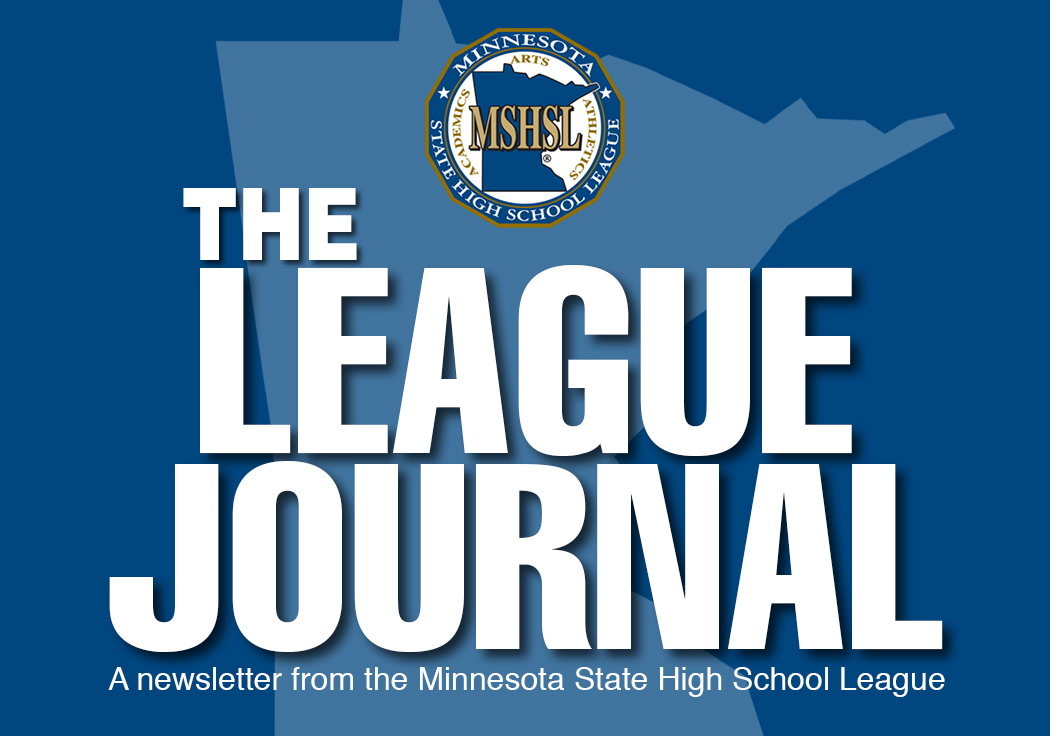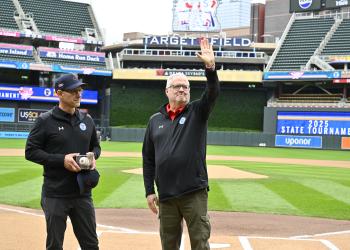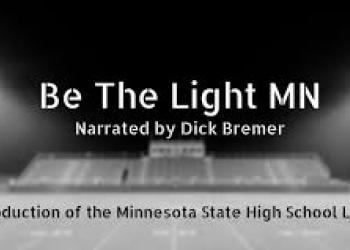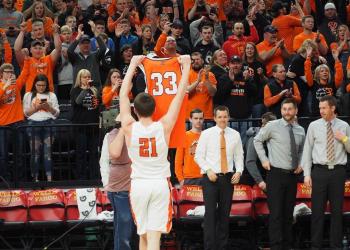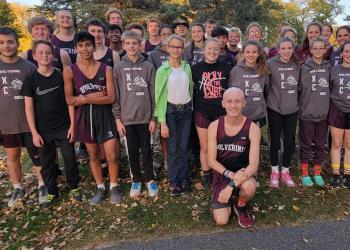John’s Journal: After 21 Years, Minnesota Is Covered With Turf
From Forest Lake To Cottonwood, Communities Celebrate
Posted: Sunday, October 24, 2021 - 3:43 PM
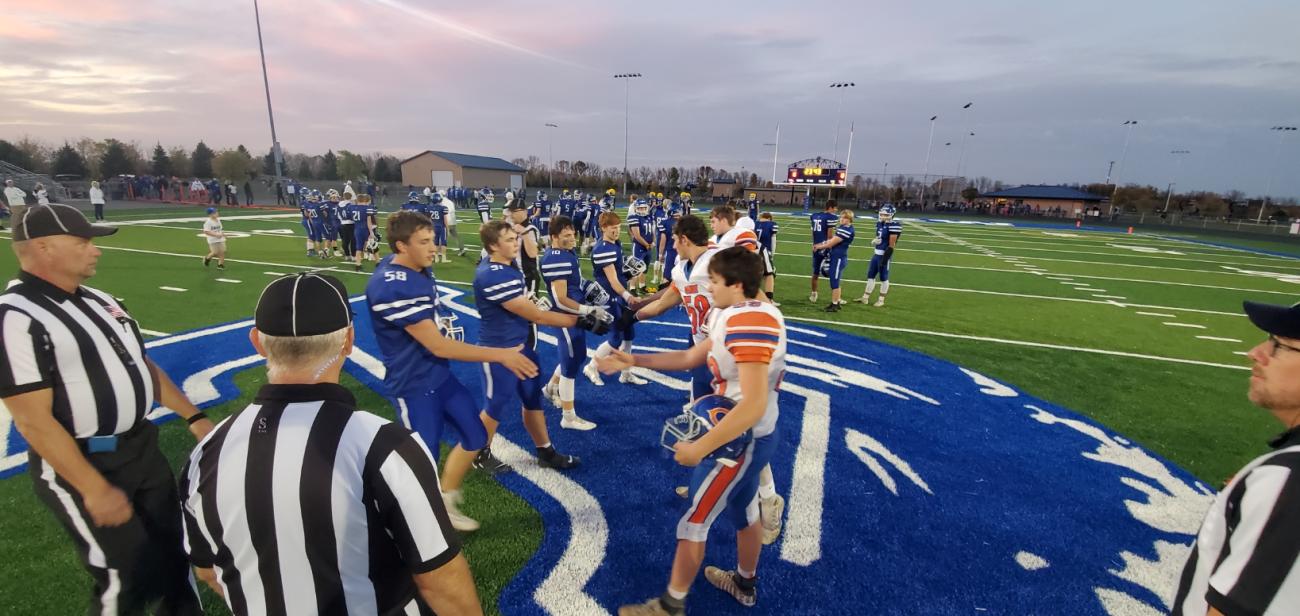
Officials and captains from Lakeview and Canby meet for the coin toss.
Anyone making the drive from Forest Lake Area High School to Lakeview High School in Cottonwood might want to pack a lunch. It’s a long trip, 170 miles and roughly three hours, from the northeast suburbs of the Twin Cities to the small town in southwest Minnesota.
The two schools don’t have a lot in common. Forest Lake, with an MSHSL enrollment of 1,849 students in grades nine through 12, is a large suburban school. Their teams play in the largest class in each activity, including Class 6A football. Lakeview has a 9-12 enrollment of 148 students and competes in Class A in football and other sports.
Despite their differences, as of this fall the schools have one thing in common: Both are celebrating the arrival of artificial turf as part of stadium renovations that have put both schools on the map.
“When you’ve got a facility like this, it just makes it easier for kids to rally around their community and for the community to rally around the kids,” said Lakeview football coach Scott Hanson, standing at midfield on the new turf after the Lakers played the final game of the regular season last week.
With a population of 1,220, Cottonwood has fewer residents than Forest Lake (pop. 22,347) has high school students. But the Lakers’ new stadium is a big-time addition to the school campus on the edge of town.
A press box was one of the final installs, being put in place during the final days of the regular season. A new track is waiting to be lined, which will happen before next spring. Lakeview boys who play soccer are part of a cooperative team with nearby Marshall High School (as well as Tracy-Milroy-Balaton), but football isn’t the only activity that can be played on the turf.
A home plate and batter’s boxes are painted on the turf in one corner of the field, allowing for softball and baseball to be played if the adjoining grass fields for those sports are unplayable (new lights were added to those fields as part of the stadium overhaul). Physical education classes, elementary-school recess and youth and community groups can also use the turf field.
The scoreboard that was part of the old grass field was moved behind the opposite end zone and a new, larger scoreboard was put in its old spot, meaning there is a scoreboard on each end of the stadium. There are no football play clocks, but they can be attached to the scoreboards. The new lights are bright, the public-address system is first-rate and the sound of a train whistle celebrates touchdowns by the Lakers.
Lakeview is the second-smallest school in Minnesota with its own turf field. The smallest is Mountain Iron-Buhl, with an MSHSL enrollment of 136 … 12 fewer students than Lakeview.
Forest Lake’s new stadium was designed and built from scratch. The sidelines were flipped, with the Rangers football teams and fans (of football, soccer and lacrosse) no longer having to stare into the setting sun. The home bleachers seat 2,500 – twice the population of Lakeview -- and the visitor’s side has room for another 1,000.
With a new track, the Rangers will be able to host a track and field meet next spring for the first time since 1992.
Forest Lake’s previous grass field was known for two things: a large crown running from end zone to end zone and a propensity for rain turning the place into a mud bath.
“It's nice to be able to see from one side to the other,” said Rangers football coach Sam Ferraro, a 1990 Forest Lake graduate. “There was such a big crown on here, even when I played.”
Like the field in Lakeview, Forest Lake’s new facility has bright lights atop four towers. When the Rangers score, the lights flicker off and on in celebration. A digital scoreboard shows replays, and play clocks are located behind each end zone. Both stadiums include bleachers that are compliant with the American Disabilities Act.
There are several bonus additions to the stadium in Forest Lake: a building behind one end zone with rooms for each team as well as officials, a large press box that’s the envy of every other high school in Minnesota (as well as many colleges), a new large concession/restroom/storage building and plaza area, and a second turf practice field that can be used for softball, baseball, physical education classes, etc.
New turf fields christened this year in Forest Lake, Cottonwood and elsewhere provide the latest chapter in the history of high school turf in Minnesota. The first high school to have turf was Wayzata in 2000, with Hopkins and a few others in the metro area following closely.
In the 21 years since, turf has exploded. All 32 schools that play Class 6A football have turf fields, as do most of the 5A football schools and lots of schools in smaller classes. Some large schools have four or five turf fields.
“Look around the metro and it’s hard to find 10 schools that don’t play on turf,” said Hopkins activities director Dan Johnson, whose school was one of the first to add turf to its stadium and now has turf fields as part of an on-campus baseball/softball/soccer complex.
Hopkins hasn’t played a football game on grass in two years, and that was at Forest Lake’s old field.
“I think it's going to do a lot of good things for the program, and obviously it's a great facility,” Forest Lake’s Ferraro said of the Rangers’ new home. “It's fun to be out here. We’ve had decent numbers (of football players) but I think our numbers will start going up, we're trying to get more youth games out here. People want to be out here.”
Before construction began in Forest Lake, the football players were the last people to set foot on the old grass field. The night before heavy equipment would rip apart the grass, the Rangers played seven-on-seven and had fun together.
“So we were the last people on the field, and then we made sure, the first day we could come out, that we got out here so we were the first ones on the new field,” Ferraro said. “They take a lot of pride in this.”
That same type of pride is felt in Cottonwood, where the Lakeview Lakers played all their regular-season home games on turf and all their road games on grass.
“We've used this field so much more this year,” Hanson said. “We have recess out here, P.E. classes out here, the communities use it, our youth football has used it, everybody has used it.
“When the community comes together for the school and the youth, this is what happens.”
--MSHSL media specialist John Millea has been the leading voice of Minnesota high school activities for decades. Follow him on Twitter @MSHSLjohn and listen to "Preps Today with John Millea” wherever you get podcasts. Contact John at [email protected]
Small Schools With Turf
Some of the smallest Minnesota schools with artificial turf fields, including grade 9 through 12 MSHSL enrollments:
--Mountain Iron-Buhl 136
--Lakeview 148
--Russell-Tyler-Ruthton 177
--Janesville-Waldorf-Pemberton 206
--St. Charles 278
--Triton 306
--St. Croix Prep 375
--Esko 393

